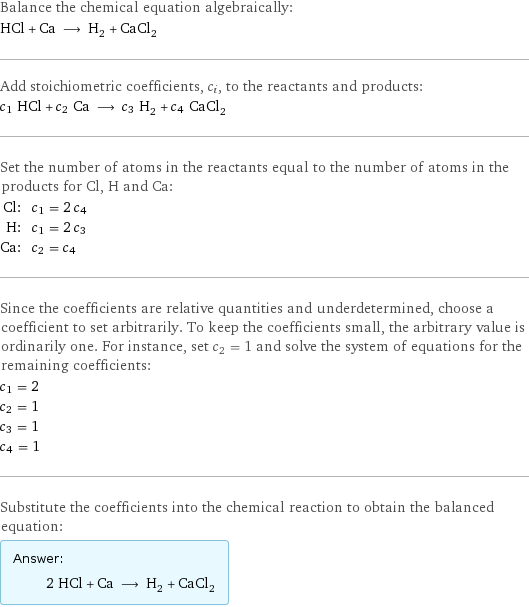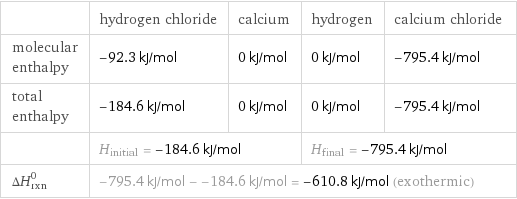Input interpretation

HCl (hydrogen chloride) + Ca (calcium) ⟶ H_2 (hydrogen) + CaCl_2 (calcium chloride)
Balanced equation

Balance the chemical equation algebraically: HCl + Ca ⟶ H_2 + CaCl_2 Add stoichiometric coefficients, c_i, to the reactants and products: c_1 HCl + c_2 Ca ⟶ c_3 H_2 + c_4 CaCl_2 Set the number of atoms in the reactants equal to the number of atoms in the products for Cl, H and Ca: Cl: | c_1 = 2 c_4 H: | c_1 = 2 c_3 Ca: | c_2 = c_4 Since the coefficients are relative quantities and underdetermined, choose a coefficient to set arbitrarily. To keep the coefficients small, the arbitrary value is ordinarily one. For instance, set c_2 = 1 and solve the system of equations for the remaining coefficients: c_1 = 2 c_2 = 1 c_3 = 1 c_4 = 1 Substitute the coefficients into the chemical reaction to obtain the balanced equation: Answer: | | 2 HCl + Ca ⟶ H_2 + CaCl_2
Structures

+ ⟶ +
Names

hydrogen chloride + calcium ⟶ hydrogen + calcium chloride
Reaction thermodynamics
Enthalpy

| hydrogen chloride | calcium | hydrogen | calcium chloride molecular enthalpy | -92.3 kJ/mol | 0 kJ/mol | 0 kJ/mol | -795.4 kJ/mol total enthalpy | -184.6 kJ/mol | 0 kJ/mol | 0 kJ/mol | -795.4 kJ/mol | H_initial = -184.6 kJ/mol | | H_final = -795.4 kJ/mol | ΔH_rxn^0 | -795.4 kJ/mol - -184.6 kJ/mol = -610.8 kJ/mol (exothermic) | | |
Equilibrium constant
![Construct the equilibrium constant, K, expression for: HCl + Ca ⟶ H_2 + CaCl_2 Plan: • Balance the chemical equation. • Determine the stoichiometric numbers. • Assemble the activity expression for each chemical species. • Use the activity expressions to build the equilibrium constant expression. Write the balanced chemical equation: 2 HCl + Ca ⟶ H_2 + CaCl_2 Assign stoichiometric numbers, ν_i, using the stoichiometric coefficients, c_i, from the balanced chemical equation in the following manner: ν_i = -c_i for reactants and ν_i = c_i for products: chemical species | c_i | ν_i HCl | 2 | -2 Ca | 1 | -1 H_2 | 1 | 1 CaCl_2 | 1 | 1 Assemble the activity expressions accounting for the state of matter and ν_i: chemical species | c_i | ν_i | activity expression HCl | 2 | -2 | ([HCl])^(-2) Ca | 1 | -1 | ([Ca])^(-1) H_2 | 1 | 1 | [H2] CaCl_2 | 1 | 1 | [CaCl2] The equilibrium constant symbol in the concentration basis is: K_c Mulitply the activity expressions to arrive at the K_c expression: Answer: | | K_c = ([HCl])^(-2) ([Ca])^(-1) [H2] [CaCl2] = ([H2] [CaCl2])/(([HCl])^2 [Ca])](../image_source/02c5fac951d0913f3ef05398ea800f10.png)
Construct the equilibrium constant, K, expression for: HCl + Ca ⟶ H_2 + CaCl_2 Plan: • Balance the chemical equation. • Determine the stoichiometric numbers. • Assemble the activity expression for each chemical species. • Use the activity expressions to build the equilibrium constant expression. Write the balanced chemical equation: 2 HCl + Ca ⟶ H_2 + CaCl_2 Assign stoichiometric numbers, ν_i, using the stoichiometric coefficients, c_i, from the balanced chemical equation in the following manner: ν_i = -c_i for reactants and ν_i = c_i for products: chemical species | c_i | ν_i HCl | 2 | -2 Ca | 1 | -1 H_2 | 1 | 1 CaCl_2 | 1 | 1 Assemble the activity expressions accounting for the state of matter and ν_i: chemical species | c_i | ν_i | activity expression HCl | 2 | -2 | ([HCl])^(-2) Ca | 1 | -1 | ([Ca])^(-1) H_2 | 1 | 1 | [H2] CaCl_2 | 1 | 1 | [CaCl2] The equilibrium constant symbol in the concentration basis is: K_c Mulitply the activity expressions to arrive at the K_c expression: Answer: | | K_c = ([HCl])^(-2) ([Ca])^(-1) [H2] [CaCl2] = ([H2] [CaCl2])/(([HCl])^2 [Ca])
Rate of reaction
![Construct the rate of reaction expression for: HCl + Ca ⟶ H_2 + CaCl_2 Plan: • Balance the chemical equation. • Determine the stoichiometric numbers. • Assemble the rate term for each chemical species. • Write the rate of reaction expression. Write the balanced chemical equation: 2 HCl + Ca ⟶ H_2 + CaCl_2 Assign stoichiometric numbers, ν_i, using the stoichiometric coefficients, c_i, from the balanced chemical equation in the following manner: ν_i = -c_i for reactants and ν_i = c_i for products: chemical species | c_i | ν_i HCl | 2 | -2 Ca | 1 | -1 H_2 | 1 | 1 CaCl_2 | 1 | 1 The rate term for each chemical species, B_i, is 1/ν_i(Δ[B_i])/(Δt) where [B_i] is the amount concentration and t is time: chemical species | c_i | ν_i | rate term HCl | 2 | -2 | -1/2 (Δ[HCl])/(Δt) Ca | 1 | -1 | -(Δ[Ca])/(Δt) H_2 | 1 | 1 | (Δ[H2])/(Δt) CaCl_2 | 1 | 1 | (Δ[CaCl2])/(Δt) (for infinitesimal rate of change, replace Δ with d) Set the rate terms equal to each other to arrive at the rate expression: Answer: | | rate = -1/2 (Δ[HCl])/(Δt) = -(Δ[Ca])/(Δt) = (Δ[H2])/(Δt) = (Δ[CaCl2])/(Δt) (assuming constant volume and no accumulation of intermediates or side products)](../image_source/c92d85a7f0d3eaa4de8ab24a310e353a.png)
Construct the rate of reaction expression for: HCl + Ca ⟶ H_2 + CaCl_2 Plan: • Balance the chemical equation. • Determine the stoichiometric numbers. • Assemble the rate term for each chemical species. • Write the rate of reaction expression. Write the balanced chemical equation: 2 HCl + Ca ⟶ H_2 + CaCl_2 Assign stoichiometric numbers, ν_i, using the stoichiometric coefficients, c_i, from the balanced chemical equation in the following manner: ν_i = -c_i for reactants and ν_i = c_i for products: chemical species | c_i | ν_i HCl | 2 | -2 Ca | 1 | -1 H_2 | 1 | 1 CaCl_2 | 1 | 1 The rate term for each chemical species, B_i, is 1/ν_i(Δ[B_i])/(Δt) where [B_i] is the amount concentration and t is time: chemical species | c_i | ν_i | rate term HCl | 2 | -2 | -1/2 (Δ[HCl])/(Δt) Ca | 1 | -1 | -(Δ[Ca])/(Δt) H_2 | 1 | 1 | (Δ[H2])/(Δt) CaCl_2 | 1 | 1 | (Δ[CaCl2])/(Δt) (for infinitesimal rate of change, replace Δ with d) Set the rate terms equal to each other to arrive at the rate expression: Answer: | | rate = -1/2 (Δ[HCl])/(Δt) = -(Δ[Ca])/(Δt) = (Δ[H2])/(Δt) = (Δ[CaCl2])/(Δt) (assuming constant volume and no accumulation of intermediates or side products)
Chemical names and formulas

| hydrogen chloride | calcium | hydrogen | calcium chloride formula | HCl | Ca | H_2 | CaCl_2 Hill formula | ClH | Ca | H_2 | CaCl_2 name | hydrogen chloride | calcium | hydrogen | calcium chloride IUPAC name | hydrogen chloride | calcium | molecular hydrogen | calcium dichloride